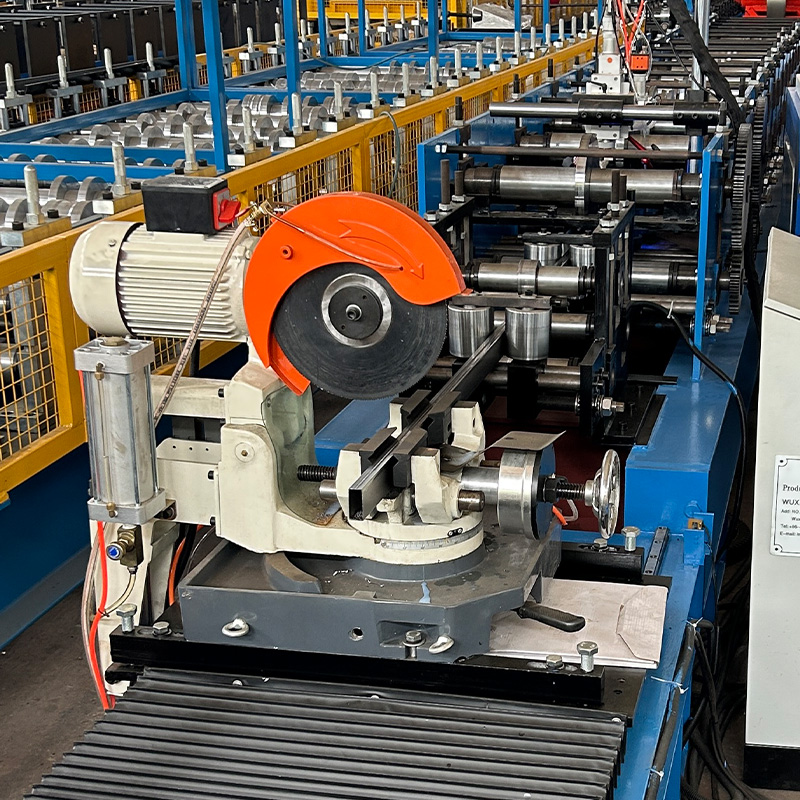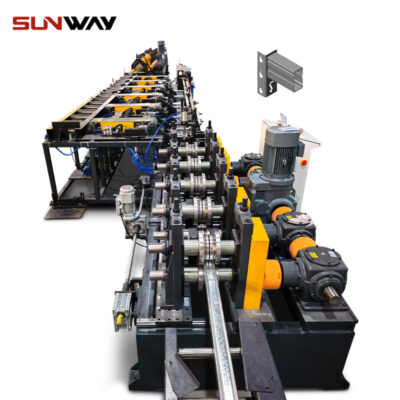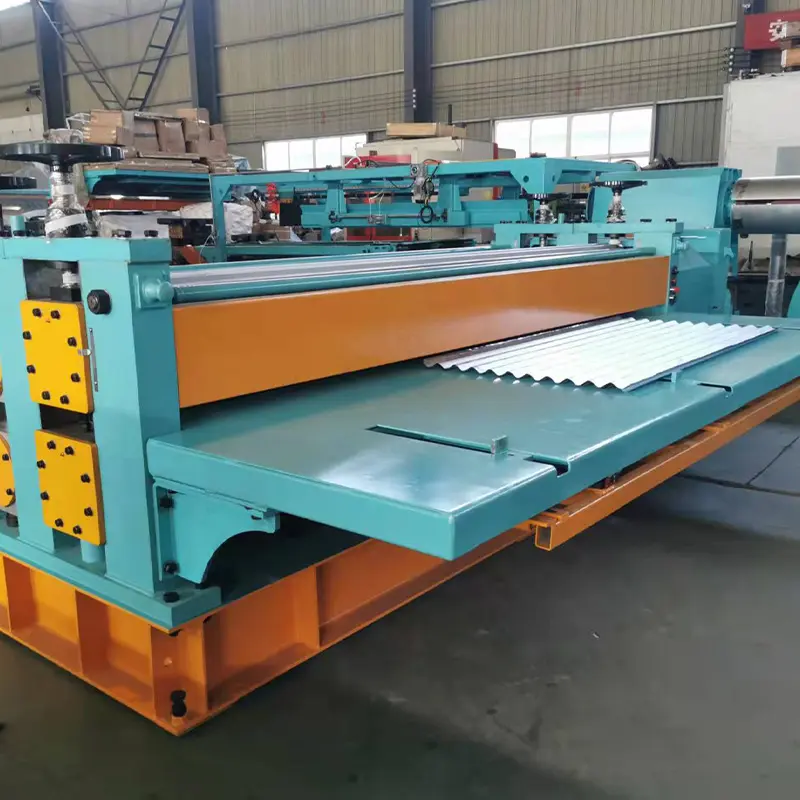The world of transportation relies on a silent workhorse behind the scenes: the carriage board making machine. Imagine a colossal machine that transforms sheets of metal into the very foundation of trucks, trailers, and shipping containers. These unsung heroes churn out the building blocks that keep our world’s goods moving efficiently. But how exactly do these machines work, and what makes them such crucial components in the transportation industry? Buckle up, because we’re diving deep into the fascinating world of carriage board making machines!
What is a Carriage Board Making Machine?
A carriage board making machine, also known as a रोल बनाने की मशीन or panel forming machine, is a specialized piece of industrial equipment designed to continuously shape metal sheets into specific profiles. Think of it as a high-tech metal origami master, precisely folding and bending the material to create the desired shapes for carriage boards. These carriage boards, often made from galvanized steel or aluminum, form the walls, floors, and roofs of trailers, trucks, and shipping containers.
The Application of Carriage Board Making Machine
The applications of carriage board making machines extend far beyond your typical truck or trailer. Here’s a glimpse into the diverse world they serve:
- Transportation: This is their bread and butter! Carriage boards form the backbone of trucks, trailers, shipping containers, and even recreational vehicles.
- Construction: Prefabricated buildings and metal structures often utilize carriage boards for their walls and roofing.
- Agriculture: Grain silos and storage containers frequently rely on carriage boards for their sturdy construction.
- HVAC: Air ducts and ventilation systems sometimes incorporate carriage boards for their lightweight yet durable properties.
As you can see, carriage board making machines play a vital role in shaping various industries that rely on robust and efficient metal structures.

How Does a Carriage Board Making Machine Work?
The magic of a carriage board making machine lies in its intricate interplay of mechanics and automation. Here’s a simplified breakdown of the process:
- Feeding the Beast: The process starts with feeding metal coils (sheets of steel or aluminum) into the uncoiler, which unwinds the material.
- Shaping Up: The metal sheet then travels through a series of rollers, each strategically positioned to bend and fold the material into the desired profile. Imagine a series of cookie cutters, but instead of shaping dough, they’re shaping metal with incredible precision.
- The Finishing Touches: After taking shape, the formed carriage board might undergo additional processes like punching holes or cutting to length, depending on the specific application.
- Ready for Action: Finally, the completed carriage board exits the machine, ready to be used in construction or further assembled into a larger structure.
The Brains Behind the Brawn: Modern carriage board making machines are marvels of automation. Programmable logic controllers (PLCs) orchestrate the entire process, ensuring precise control over the speed, pressure, and positioning of the rollers. This automation allows for consistent quality and high production rates.
Different Types of Carriage Board Making Machines
Not all carriage board making machines are created equal. Here’s a breakdown of the two main types:
- Hydraulic Carriage Board Making Machine: These machines utilize hydraulic pressure to drive the forming rollers, offering high power and flexibility for handling thicker materials. Think of them as the weightlifters of the carriage board making world. However, they tend to be more complex and expensive compared to their electric counterparts.
- Electric Carriage Board Making Machine: These machines rely on electric motors to power the forming rollers. They offer a simpler design, making them more cost-effective and easier to maintain. However, their power output might limit them to working with thinner metal sheets.
The choice between these two types depends on the specific needs of the manufacturer. For instance, if the focus is on handling heavy-duty materials like thick steel for truck trailers, a hydraulic machine might be the better choice. On the other hand, for lighter gauge aluminum used in building panels, an electric machine might suffice.
-
 Storage Rack Shelf Box Panel Making Machine Steel Storage Rack System Box Beam Roll Forming Line
Storage Rack Shelf Box Panel Making Machine Steel Storage Rack System Box Beam Roll Forming Line -
 Highway Guardrail End Terminal Forming Machine
Highway Guardrail End Terminal Forming Machine -
 Highway U/C Post Roll Forming Machine
Highway U/C Post Roll Forming Machine -
 2 Waves Highway Guardrail Roll Forming Machine
2 Waves Highway Guardrail Roll Forming Machine -
 3 Waves Highway Guardrail Roll Forming Machine
3 Waves Highway Guardrail Roll Forming Machine -
 वाइनयार्ड पोस्ट रोल बनाने की मशीन
वाइनयार्ड पोस्ट रोल बनाने की मशीन -
 ऑटो आकार बदलने योग्य सिग्मा शहतीर रोल बनाने की मशीन
ऑटो आकार बदलने योग्य सिग्मा शहतीर रोल बनाने की मशीन -
 ऑटो आकार बदलने योग्य CZ शहतीर रोल बनाने की मशीन
ऑटो आकार बदलने योग्य CZ शहतीर रोल बनाने की मशीन -
 ऑटो आकार बदलने योग्य Z शहतीर रोल बनाने की मशीन
ऑटो आकार बदलने योग्य Z शहतीर रोल बनाने की मशीन
Choosing a Carriage Board Making Machine
Investing in a carriage board making machine is a significant decision. Here are some key factors to consider:
- Production Requirements: How much material do you need to process per day or week? Matching the machine’s capacity to your production needs is crucial.
- Material Thickness and Type: The type of carriage board you plan to produce (steel, aluminum, etc.) and its thickness will determine the machine’s capability requirements.
- Desired Features: Do you need additional functionalities like punching or cutting? Some machines offer these features as add-ons.
- Budget: Carriage board making machines can range in price from tens of thousands of dollars for basic electric models to hundreds of thousands for high-end hydraulic machines with advanced features. Carefully assess your budget and choose a machine that offers the necessary capabilities without breaking the bank.
- Reputation and Service: Research the reputation of the machine manufacturer and their after-sales service network. Reliable service and readily available spare parts are crucial for maintaining smooth operations.
Beyond the Basics: Advanced Features of Carriage Board Making Machines
While the core functionality remains the same, some carriage board making machines boast additional features that can enhance productivity and efficiency:
- Automatic Stacking and Palletizing: These systems automatically stack and palletize the finished carriage boards, reducing manual labor and increasing production speed.
- Roll Feeding Systems: Advanced machines might incorporate automated roll feeding systems that continuously feed new material coils as the old ones deplete, minimizing downtime.
- Computer-Aided Design (CAD) Integration: Some machines integrate with CAD software, allowing for the creation and implementation of new carriage board profiles directly into the machine’s control system.
These advanced features can significantly improve a manufacturer’s production capabilities and competitiveness.
Top Players in the Carriage Board Making Machine Market
The carriage board making machine market is a competitive landscape with several established players. Here are some of the leading names:
- Jinan Rainertech Machinery Industries Co., Ltd. (China): A prominent Chinese manufacturer known for its high-quality and affordable roll forming machines.
- Aksu Miracle Machinery Co., Ltd. (China): Another major Chinese player offering a wide range of carriage board making machines with a focus on customization.
- Dayu Machinery Manufacturing Co., Ltd. (Taiwan): A Taiwanese manufacturer recognized for its innovative and user-friendly machine designs.
- Murata Machinery Ltd. (Japan): A Japanese giant renowned for its advanced and technologically sophisticated machinery, often at a premium price point.
- Roll Forming Machine LLC (USA): An American company specializing in high-performance and durable carriage board making machines, catering primarily to the North American market.
Choosing the Right Partner: Researching these leading manufacturers and their offerings is crucial when making a purchasing decision. Consider factors like machine specifications, reputation, after-sales service, and compatibility with your specific needs.
The Future of Carriage Board Making Machines
The future of carriage board making machines is brimming with exciting possibilities. Here are some trends to watch out for:
- Increased Automation: Expect even higher levels of automation, including features like self-diagnostics and predictive maintenance capabilities.
- Smart Manufacturing Integration: Integration with smart manufacturing initiatives will allow for real-time production monitoring and optimization.
- Sustainable Materials: With a growing focus on sustainability, machines might be adapted to handle eco-friendly materials like recycled steel or bio-composites.
- Advanced Roll Forming Technologies: Innovations in roll forming technology might lead to the creation of even more intricate and lightweight carriage board profiles.
These advancements promise to further improve the efficiency, versatility, and sustainability of carriage board making machines, solidifying their place as vital contributors to the transportation and construction industries.

सामान्य प्रश्न
Table 1: Frequently Asked Questions on Carriage Board Making Machines
| Question | Answer |
|---|---|
| What materials can a carriage board making machine work with? | Most commonly, these machines handle galvanized steel and aluminum. However, some advanced models can also work with other materials like stainless steel or even composite materials. |
| What are the safety considerations when operating a carriage board making machine? | Safety is paramount. Following proper operating procedures, wearing appropriate personal protective equipment (PPE), and maintaining the machine regularly are crucial to prevent accidents. |
| How long does it take to produce a single carriage board? | Production time depends on the machine’s speed, the complexity of the profile, and the length of the board. It can range from a few seconds to several minutes. |
| What are the maintenance requirements for a carriage board making machine? | Regular maintenance is essential for optimal performance and longevity. This includes cleaning the rollers, lubricating moving parts, and inspecting for wear and tear. |
| Where can I find more information about carriage board making machines? | Numerous resources are available online, including manufacturer websites, industry publications, and trade associations. Additionally, attending industry events can provide valuable insights and networking opportunities. |
By understanding the intricacies of carriage board making machines, their applications, and the factors to consider when choosing one, manufacturers can make informed decisions to optimize their production capabilities and contribute to the ever-evolving transportation and construction landscape.
